Environmental Justice Showcase Communities by Region
The U.S. Environmental Protection Agency has committed $1,000,000 to address environmental justice challenges in ten communities across the nation. The Agency is providing $100,000 per project over the next two years to help alleviate the environmental and human health challenges facing many American communities.
The Environmental Justice Showcase Communities effort brings together governmental and non-governmental organizations and pools their collective resources and expertise on the best ways to achieve real results in communities.
Each Region throughout the country has communities with Environmental Justice concerns including:
- multiple, disproportionate environmental health burdens
- population vulnerability
- limits to effective participation in decisions with environmental and health consequences
- opportunities for multiple federal, state and local agency collaboration, with a focus on green development
Therefore, EPA will work to improve collaboration in the delivery of services to support communities with environmental justice issues. The successes and lessons learned in these demonstration projects will be used to help guide the design and implementation of future Environmental Justice projects and will help EPA increase its ability to address local environmental challenges in more effective, efficient and sustainable ways.
Region 1 EJ Showcase Community: Bridgeport, CT
Overview
EPA Region 1 is building on work that has already taken place to develop community capacity and engagement, identify a broad network of partnerships, and connect with the goals of the city government. Using this past work as a foundation, the Region plans to work collaboratively with a wide-range of stakeholders to develop projects focused on improving indoor air quality, increasing community capacity for green jobs, increasing recycling rates, and reducing asthma and toxic exposure.
Successes
- Removed 600 tons of contaminated soils from an industrial site.
- Leveraged a commitment from the City to invest $1 million dollars to provide low income communities with access to parks along the Bridgeport waterfront.
- Supported the awards of wastewater and drinking water handler certifications to 51 inner city youths.
- Supported stormwater management training for 20 inner city youths and a two-week "Water Boot Camp" for 18 public school students.
- Provided greenscaper training to 28 workers in small and minority landscaping and contracting/construction businesses.
- Other Successes: Region 1 also supported funding awards totaling approximately $16 Million, improved recycling at Bridgeport public schools, supported a hospital pollution prevention workshop attended by 50 persons, supported in home asthma training, contributed to the cleanup of the Bridgeport waterfront, and participated in the Pequonnock River Initiative.
History
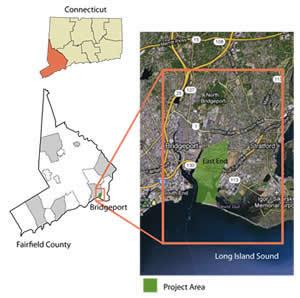
EPA Region 1, together with state, county, city, non-profit, and community organizations, is working with several communities in Bridgeport on a series of environmental justice issues affecting human health and the ambient environment. The Project was designed to expand collaboration among a range of diverse stakeholders in order to solve some substantial environmental issues. Region I has programs designed to improve indoor air quality, encourage green jobs in the community, increase recycling rates, and reduce asthma and toxic exposure in schools and homes. The region awarded $100,000 to support the programming. The Region awarded $25,000 to the Bridgeport Board of Education and the City of Bridgeport to pilot a paper recycling program at two local schools. The Connecticut Coalition for Environmental Justice , a community based organization, will coordinate a community fair focused on asthma, bringing together city organizations working on asthma and healthy homes to effectively share resources.
Green jobs and youth development have been critical program elements. To attract young people into water industry careers, EPA New England worked with the Connecticut Section of the American Water Works Association, the Water and People Program, and the public schools to establish a Water Boot Camp. These groups are leading the way in connecting with youth to teach them about water resources and prepare them for green jobs in water operations. Groundwork Bridgeport will train and develop 20 Bridgeport youth water resource protection advocates, mark 600 street drains indicating that they drain into Long Island Sound and must be kept clean, and organize four neighborhood meetings for residents and local businesses about how they can protect water resources. The City’s Workplace, Inc. jobs training program is devising training for inner city youth to receive waste water and drinking water handler certifications. Beyond the water projects, the region facilitated Greenscaper Training at Bridgeport’s Beardsley Zoo. The training focused on vegetated rain gardens as a way to control stormwater runoff.
The Region has worked with the Port Authority to make them aware of basic compliance and sustainability issues, including requirements for large ocean-going ships visiting or passing by Bridgeport within 200 nautical miles of shore having to burn lower-sulfur fuel. At the request of some community groups and the City, EPA funded a removal at the Chrome Engineering site. EPA disposed of contaminated soil using innovations that render contaminated soils non-hazardous. The Agency is also participating in the Pequonnock River Initiative, a partnership between the City of Bridgeport and the towns of Monroe and Trumbull to develop a watershed plan for the Pequonnock River watershed. The Region has also sought to leverage resources to restore portions of Johnson’s Creek and Pleasure Beach. Fish and Wildlife has been a participant along with a number of nongovernmental organizations.
Finally, the Region has learned that more training is essential. The Region will provide an overview of environmental laws, compliance assistance, land use planning and restoration, and climate change awareness training. Much of this work will be done with the support of the stakeholders and through a $25,000 grant from EPA to the Rhode Island Legal Services. The firm will develop the New England Environmental Justice Forum and organize up to three trainings for EJ groups and their advocates.
Bridgeport was awarded one of its largest federal grants ever, an $11 million TIGER grant, or Transportation Investment Generating Economic Recovery. This grant will help prepare the harbor-side of Steel Pointe for development by funding infrastructure improvements, and will be matched by an $18 million contribution by developer Bridgeport Landing LLC.
Bridgeport also received part of a $3.5 million Sustainable Communities grant, which will pay for a feasibility study into a potential new train station on the East Side and benefit the New York City to New Haven corridor.
For more information or to become involved, please contact Deborah Brown (brown.deborah@epa.gov), EPA New England, at 617-918-1706.
Region 2 EJ Showcase Community: Staten Island, NY
Overview
EPA Region 2 is working with the North Shore of Staten Island, a former industrial community that contains abandoned, contaminated, and regulated properties along the waterfront, because the neighborhood has seen an increase in the number of kids with elevated lead levels in their blood. EPA, in consultation with key community members, state and local health agencies, is developing a community-based health strategy for the area.
Successes
- Investigated and resolved concerns associated with 21 sites identified by the community.
- Supported a kickoff meeting held by local organizations.
- Provided regulatory and technical support and leveraged state and local governmental support for the formation of a local coalition comprised of 30 groups
- Providing significant resources to support projects selected by the new coalition.
History
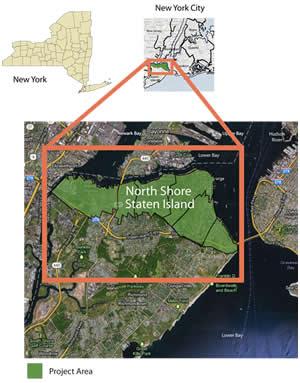
EPA has been working closely with the North Shore of Staten Island, a former industrial community that contains many abandoned, contaminated, and regulated properties along the waterfront. EPA, in consultation with key community members and state and local environmental and public health agencies, is seeking to develop a community-based environmental health strategy for the area.
To date, Region 2 has launched a comprehensive, multi-program strategy to investigate local environmental concerns. Among activities undertaken include:
- Establishing a Regional Task Force to respond to potential environmental concerns related to 21 sites of interest, as identified by a local EJ community organization;
- Conducting a regional compliance initiative to evaluate children’s potential exposure to pesticides from indoor and/or outdoor pesticide applications at child care facilities;
- Supporting the formation of a local coalition - comprised of environmental groups, EJ, civic, and tenant associations - in the North Shore area, which will be instrumental in the further prioritization of local environmental and public health concerns and serve to attract additional resources and build partnerships among public and private institutions.
In addition, EPA Region 2 continues to leverage, where appropriate, the support and assistance of government, business, and community organizations involved in local brownfields redevelopment projects within the north shore, including the 107-acre Mariners Marsh property, Richmond Terrace/Kill Van Kull waterfront, and the Port Richmond Brownfield Opportunity Area.
For the remainder of the showcase project, Region 2 will secure a broad-based technical assistance contract to offer a range of services to support efforts involving the local coalition and potential project partners.
These services may include the development and implementation of:
- a community outreach campaign;
- a community-based environmental health training program, including educational materials;
- the interpretation of existing environmental and public health data in a manner community members can understand; and
- the solicitation of other governmental and nongovernmental entities to join the EJ Showcase Community project.
For more information or to become involved, please contact Terry Wesley (wesley.terry@epa.gov), EPA Region 2, at 212-637-5027.
Region 3 EJ Showcase Community: Washington, DC Wards 7 and 8
Overview
EPA Region 3 is building on its Environmental Justice work with a variety of partners, such as: the District Department of Environment; the District Department of Health; and, local recipients of Environmental Justice Collaborative Problem Solving and Environmental Justice Small Grant awards.
Successes
- Facilitated and funded a green infrastructure job training project in southeast DC.
- Created a community consensus statement on contaminated properties.
- Convened three major workgroups with stakeholder groups around the District to address community needs.
- Supported three consensus building meetings held by the Children’s Environmental Health Workgroup (CEHW).
- Leveraged EPA funding for the CEHW Healthy Homes Project.
History
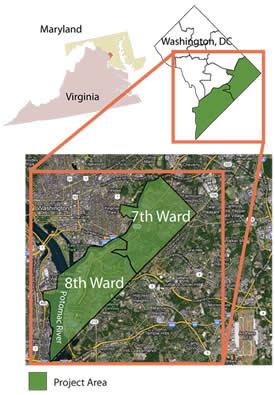
The Region established an initial stakeholder working group made up of EPA Region III, members of the District of Columbia Environmental Health Collaborative coordinated by the Coalition for Environmentally Safe Communities (CESC) and the Children’s Environmental Health Network (with as many as 40 organizations), and the District of Columbia Department of the Environment.
The project is working in communities that exhibit characteristics common to neighborhoods suffering from environmental injustices including poverty, high ethnic minority populations, degraded infrastructure, poor access to environmental and other amenities, high asthma rates, child lead exposure, and so on. Region 3 has forged connections with:
- the District’s Department of Environment (DDOE) and Department of Health;
- the U.S. Department of Interior (including National Park Service and Fish and Wildlife Service);
- the Department of Labor; and
- numerous other agencies, non-governmental groups, and community organizations within the District.
The first phase of data gathering for the project has been completed. The data report was presented to the public on March 20, 2010. The issues and concerns identified in the report and through forum interactions with the community identify lead asthma, children’s health, and hazardous facilities as concerns. In addition, forum participants were also concerned with pesticides, subsistence fishing, children’s health, day care centers, vehicle idling, and green jobs/green economy.
The planning committee compiled all of the information gathered and developed a listing of critical issues:
- Green Economy/Green Jobs,
- Children’s Environmental Health, and
- Contaminated Properties.
The three work groups held stakeholder meetings throughout the fall and winter, developing action plans for their projects.
The Showcase Communities Project can already point to several successes, such as facilitating the development, funding and implementation of a green jobs project in Southeast Washington, DC. The project built community capacity on green infrastructure best management practices and Brownfields revitalization. The partners will deliver green infrastructure training to 250 Job Corps Center construction trade students, install demonstration rain-harvesting technologies and hold community workshops.
The Green Economy Workgroup formed a committee under and facilitated a partnership between member NGOs and DDOE. This effort will provide a local pool of trained cleanup workers to address many of the contaminated sites within the District.
The Children’s Environmental Health Workgroup developed the following project with its stakeholders. The goal of this project is to launch a comprehensive healthy homes, healthy schools and healthy child care program that will address multiple environmental health and safety hazards in Ward 8 in the District of Columbia.
The Contaminated Properties Workgroup is developing an informational community forum regarding contaminated sites in the District of Columbia, with the goal of supporting education and advocacy, and fostering environmental stewardship amongst the community. The group is looking to hold a broad based stakeholder forum. For more information or to become involved, please contact Reginald Harris (harris.reggie@epa.gov) at 215-814-2988.
Region 4 EJ Showcase Community: Jacksonville, FL Health Zone 1
Overview
EPA Region 4 is working with the City of Jacksonville and numerous local stakeholders to improve environmental and public health outcomes in an area that consists of a predominantly low income and minority population. This area has a number of Superfund sites, Brownfields, vacant and abandoned lots or other properties where contamination is suspected and impacted waterways. Region 4 is working with its partners, including environmental justice community representatives, to address sites of concern and turn them into an opportunity for residents in the vicinity to collaborate with developers and revitalize their neighborhoods.
Successes
- Completed a comprehensive study of fish and shellfish in two local fishing streams.
- Posted 24 fish consumption advisory signs to protect public health.
- Conducted “build your own” rain barrel and community garden workshops to improve public health, provide fresh food, and address stormwater pollution for improving local water quality.
- Provided three community-industry forums to improve communications by fostering community-industry dialogue.
- Conducted a series of “shared learning” workshops to advance community integrated planning toward development of a community-based improvement plan (health care, healthy food, open green space).
- Reduced exposures of neighborhood children to asthma triggers and lead-based paint.
History

The Jacksonville EJ Showcase Community project is a multi-year partnership comprising federal, state, and local government and community partners. A key element of the Jacksonville project is the community’s goal of increasing access to health and health care. In the face of numerous public health needs, the community is particularly concerned about the lack of access to health care services and prevention opportunities. The community’s vision is to establish a health center located on a remediated brownfields that would provide essential comprehensive, culturally competent and quality primary health care services, and holistic, integrated health care. The vision integrates sustainability principles, including green building design, walkability and public transportation choices, and food security.
In support of the community’s vision, there are collaborative efforts underway with other federal agencies. The Department of Housing and Urban Development (HUD) - Department of Transportation (DOT) -EPA Partnership for Sustainable Communities has recognized the importance of this effort to link environmental justice, public health and sustainability. HUD selected the Jacksonville project as a Partnership for Sustainable Communities Signature Project to explore how housing can be used to make HUD-assisted low-income households more economically self sufficient, environmentally safe, and health vibrant. In addition, a dialogue is underway with the Department of Health and Human Services (HHS) agencies on opportunities to achieve the Community’s health and health care goals through provisions of the Affordable Care Act.
In the spring and summer of 2010, EPA Region 4 sought to partner with governmental, non-governmental and community-based organizations to identify priority public health and environmental challenges existing in Jacksonville’s Health Zone 1.
Data collection, communication, and coordination by all of the partners resulted in the creation of a Community Action Plan (CAP) which strategically targets public health and environmental improvements, and supplements the ongoing sustainability efforts in Health Zone 1.
The following are integral to the CAP and the sustainability of efforts planned for Health Zone 1:
- asthma and lead-based paint educational outreach and awareness activities;
- urban creek water quality assessments; and
- community capacity building and involvement activities.
Additionally, through the collective efforts of federal, state and local agencies and community-based organizations, the project has generated sustainable support to increase the Region’s ability to achieve public health and environmental results throughout the Health Zone 1 community.
In October, 2010, EPA Region 4 hosted a community forum to launch the CAP. Implementation of CAP activities began soon after, and is expected to continue through September 2011. The expected project outcomes are to develop long term solutions from a “bottom-up” approach and to demonstrate the importance of building collaborative relationships to engage in constructive problem-solving and reaching common goals.
Read the latest newsletter (PDF) (7 pp, 204K, about PDF)
For more information or to become involved, please contact Reginald Barrino (barrino.reginald@epa.gov), 404-562-9635
Region 5 EJ Showcase Community: Milwaukee, WI 30th Street Corridor
Overview
EPA Region 5 is working to further the redevelopment of the 30th Street Industrial Corridor. The corridor, a former rail line in the north-central part of the city, is home to low income, communities of color. This project seeks to improve the human, environmental and economic health of these neighborhoods by redeveloping Brownfields along the corridor, implementing environmentally preferable stormwater management practices, and developing urban agriculture.
Successes
- Used geographic-based targeted enforcement to assess facilities in the EJ community.
- Conducted 25 tank and facility inspections and 7 multi-media investigations to assess potential impacts on the communities.
- Supported revitalization with $1.3 million to the City and 4 brownfields assessment grants, totaling $800,000, to the State to assess and remediate 200 known sites.
- Reached over 100 local families with training on blood lead screening, asthma testing, lead paint removal and healthy home practices.
- Provided training to over 170 community health workers (CHWs) and healthcare providers.
- Conducted hazard training in 90 public schools and removed 100 pounds of hazardous chemicals.
- Provided lead abatement training to 63 contractors and handymen.
History
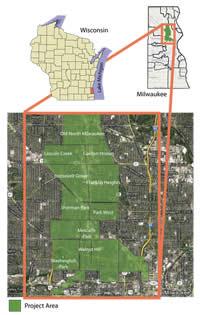
Milwaukee is facing and overcoming an aggregation of problems from its industrial past and declining manufacturing base: brownfields sites, old housing stock, loss of jobs, high unemployment, vacant lots, low educational attainment, and high asthma rates and high blood lead levels in children. The brownfields properties threaten public health, the environment, and neighborhood communities in a number of ways including contaminants in the soil, air and water, as well as rodent infestations, trash dumping, and unsafe buildings. Region 5, in partnership with the City of Milwaukee, Wisconsin Department of Natural Resources, Public Health Agencies and organizations, non-governmental organizations (NGOs), and neighborhood organizations are implementing a range of projects to address the public health concerns through education, health care worker training, and healthy home intervention; to reduce environmental issues through targeted enforcement actions, inspections, and cleanups; and to engage the neighborhoods in conversation and collaboration.
Fight Asthma Milwaukee and Milwaukee Area Health Education Center (AHEC) partnered with Region 5 for asthma awareness training and Healthy Homes approaches to control and reduce indoor environmental asthma triggers. The training reached more than 50 community health workers, case managers, and other professionals involved with home visitation programs that are trusted by community residents.
Children’s health in low income and minority neighborhoods may be at risk from the conditions at home, in school and other sources. Region 5 participated in annual training in safe chemicals management for 46 head science teachers and Environmental Health and Safety staff from Milwaukee Public Schools (MPS). This training is part of an ongoing effort by MPS to improve their school environments and ensure the health and safety of students and staff. The participants, who serve as Chemical Hygiene Officers for their respective schools, learned principles of risk and children's health, laboratory safety, principles of safe chemical handling, and green chemistry. Additional training and technical assistance activities for reducing exposures to laboratory chemicals focuses on area charter and private schools.
Milwaukee is converting former brownfields property to urban gardens which are leased to organizations or neighborhood groups. An urban garden was constructed on a parcel of the former Esser facility in the Corridor as a result of a partnership between the City, State, EPA, and other institutions. On Earth Day 2010, it was dedicated as the Hmong American Friendship Garden, which will be managed and used by the Hmong community.
A partnership comprised of EPA Region 5, the Milwaukee Food Council, Center for Resilient Cities, Growing Power, the city of Milwaukee and the state of Wisconsin will explore how to connect the growing demand for urban gardens with public policies and improved access to healthy foods. More than 20 organizations are working together to form a roadmap for moving forward.
Because brownfields and vacant industrial facilities are obstacles to the revitalization partnership of Region 5, Milwaukee and the State have conducted brownfields assessments of over 50 properties, with more planned. Using Recovery Act-Leaking Underground Storage Tanks funding, they are removing tanks and cleaning up 17 projects in preparation for redevelopment. In the fall of 2010, the City welcomed the first business, Talgo, a Spanish train car manufacturer and employer with 80 new jobs, into a redeveloped parcel in the Corridor.
Region 6 EJ Showcase Community: Port Arthur, TX
Overview
EPA Region 6 is developing and implementing a comprehensive, cross-media project in this diverse city. More than 50 percent of its residents are African American and Hispanic. The city has many facilities including chemical plants, refineries and a hazardous waste incinerator. This project is being developed, with the support of other government agencies, in response to community-based organizations who have called upon EPA to look at the cumulative effects of multiple environmental impacts in Port Arthur.
Successes
- Supported community forums on improving the quality of life for Port Arthur Westside residents.
- Engaged in partnerships with Port Arthur stakeholders and industry leading to a $1,000,000 award for a construction of a Health Clinic on the Westside of Port Arthur Texas.
- Received significant support from Administrator Jackson
- Conducted Healthy Home trainings and health outreach for 60 neighborhood residents.
- Provided emergency response training to 75 community representatives
- Supported air quality and job training and education of over 100 families on energy conservation.
- Provided school chemical cleanout training to more than 30 science teachers.
- Supported revitalization by leveraging $329,598 worth of Brownfield assessments on 1,300 properties.
History
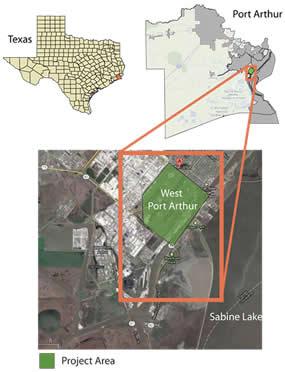
EPA Region 6 is developing and implementing a comprehensive, cross-media project in the West side community of Port Arthur, Texas. The project involves governmental officials, religious leaders, industrial officials, community leaders and citizens in a collaborative community-based approach to improve the community’s public health and the environment.
Over the last 12 months, an action plan for the project was developed. This action plan resulted in three grants and contract support for outreach and community meeting activities. The three grants included:
- A Healthy Homes Outreach Project, University of Texas Foundation in collaboration with University of Texas Medical Branch at Galveston and Community In Power and Development Association,
- An After School Environmental Science Lab Project, Tekoa Charter School, and
- The Golden Triangle Empowerment Center Job Training Program.
The primary contract support activity involves the development of an EPA ‘Environmental Profile’ outreach document. The environmental profile will be a clear concise outreach document that summarizes joint EPA and State evaluations of the best available information about environmental conditions (e.g., data and predictive tools). A City – EPA, two-day EJ Summit in Port Arthur, Texas occurred on November 8-9, 2010. The summit brought together stakeholders to discuss thoughtful strategies and approaches to improve the quality of life for Port Arthur residents. The facilitated dialogue highlighted several crucial challenges that could be effectively addressed through a thoughtful local, state and federal collaboration.
Throughout 2011, efforts will be made to begin to address six critically important issues that were identified at the EJ Summit and formalized in Port Arthur’s EJ Plan. These issues will be addressed by the formation of six issue specific workgroups composed of a cross-section of stakeholders.
There are a number of results expected from the EJ Showcase Community project. The environmental profile outreach document will inform the public of federal and state permits and authorizations, and identify opportunities for input into permit conditions. The Port Arthur EJ Plan is expected to impact environmental quality, promote the revitalization of the Downtown and Westside areas, address unemployment and significant health care challenges, improve the energy efficiency of residences, and facilitate alternative housing for residents of the Carver Terrace Assisted Housing Project.
For additional information about the Region 6 Showcase Initiative, contact Israel Anderson (anderson.israel@epa.gov), the Region 6 Associate Director for Environmental Justice at 214-665-3138.
Region 7 EJ Showcase Community: Kansas City Metropolitan Area
Overview
EPA Region 7 has identified 11 neighborhoods in the metropolitan area that have many risk factors including poor housing conditions and increased exposure to environmental hazards. EPA is conducting an assessment to identify specific sources of pollution and will work with neighborhood leaders to prioritize community concerns. Strategies to address these concerns will be developed through these partnerships.
Successes
- Provided training on water monitoring techniques to 20 community members who then monitored water quality in five urban lakes.
- Supported an all-day training workshop on Emergency Planning Community Right-to-Know (EPCRA).
- Supported a ten-week environmental awareness program.
- Supported an “Essentials for Healthy Home Practitioners” course for 50 participants.
- Hosted an urban agriculture workshop for 30 attendees.
- Sampled 15 urban lots to help community members assess whether the lots are safe for gardening and agricultural production.
- Supported community youths to produce video interviews with local elders on histories of local water bodies.
History
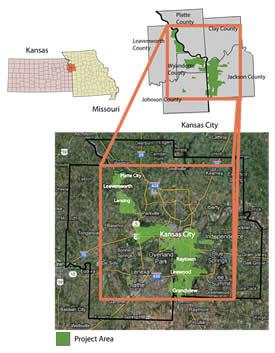
EPA Region 7 identified economically-distressed neighborhoods in the Kansas City metropolitan area for its Showcase Community. Risk factors in these neighborhoods include increased exposure to environmental hazards and poor housing conditions. Participating neighborhoods have identified the following environmental concerns:
- air quality,
- vacant and abandoned property,
- asthma,
- lead,
- poor housing conditions,
- lack of clean water,
- storm water and flooding,
- lack of urban farming,
- illegal dumping and improper waste disposal, and
- children’s health issues.
Region 7 hosted a community dialogue focusing on project planning for the Showcase. Community participants encouraged EPA to emphasizeenvironmental education and awareness, and youth engagement throughout the Showcase efforts. As a result of the meeting, three project areas are being addressed through the Showcase Community Project:
- Urban Water:
- Water Monitoring/Fish Consumption - Kansas City urban lakes and streams which are common fishing locations are included in the Region 7 monitoring activities. Monitoring kits have been given to the Blue River Watershed Association for youth water monitoring activities. Fish consumption education will be provided to locals involved in subsistence fishing.
- Intergenerational Video Project - Youth will interview local elders regarding the historical interaction with water and how it played an integral part in their life. This is in hopes to encourage youth to reconnect with local water bodies.
- Healthy Communities:
- Healthy Homes Training - A train-the-trainer approach will be used in Healthy Homes training. The target audience for this training is neighborhood leaders and staff from local community service organizations who support and engage with individuals and households who may face healthy homes challenges and who may be impacted by the associated health concerns.
- Community Emergency Preparedness Training - Neighborhood leaders and local community service staff will receive information from the Federal Emergency Management Agency (FEMA), Mid-America Regional Council (MARC), and EPA with regards to metro-area emergency plans, household emergency preparedness, and chemical risks within the community.
- Youth Environmental Awareness and Involvement - In partnership with the Greater Kansas City Boys and Girls Club Region 7 is helping to integrate environmental education into the curriculum presented to middle school and high school aged youth.
- Urban Agriculture - Re-use of Vacant and Abandoned Property Through:
- Neighborhoods within the Showcase Community area have identified spaces that are proposed agriculture sites. Region 7 will provide soil sampling and technical assistance to interpret sampling results.
- Region 7 and Showcase partners will provide technical assistance workshops to assist with site design, plant selection, and business planning. The soil sampling and technical assistance listed above are being provided through EJ Showcase resources and support from local partners.
For more information or to become involved, please contact Althea Moses (moses.althea@epa.gov) at 913-551-7649.
Region 8 EJ Showcase Community: Salt Lake City, UT
Overview
EPA Region 8 is working with six neighborhoods in central and west Salt Lake City, as the focus of a Children’s Environmental Health and Environmental Justice initiative. These neighborhoods include: Glendale, Jordan Meadows, Poplar Grove, Rose Park, State Fairpark and Westpointe. The neighborhoods were selected based on the presence of several environmental risk factors, as well as the community's support and past participation in addressing environmental issues. EPA is working closely with the community and other federal, state and local agencies to identify children's exposure to contaminants from multiple pathways and will develop and apply tools to address those issues. The State of Utah has developed a tracking system that will provide baseline health and environmental data and help the partnership achieve results.
Successes
- Developed a project process model entitled “Pathway Towards a Healthier Community” to guide project efforts.
- Completed a community environmental health needs assessment.
- Compiled neighborhood-specific environmental and health data and prepared a map of environmental features as a communication/analytical tool.
- Mobilized a core group of state, county, and city government agencies and local non-profit and community organizations.
- Held a kick-off event and children’s environmental health fair attended by approximately 250 people.
History
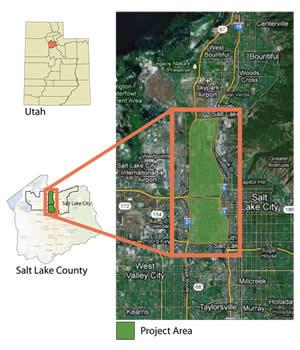
EPA Region 8, together with state, county, city, non-profit, and community organizations, is working with nine neighborhoods in central and west Salt Lake City on a community-based Children’s Environmental Health and Environmental Justice initiative. The goal of the project is to make a positive difference to the environmental health of children through collaboration and community problem solving in the following neighborhoods:
- Glendale,
- Jordan Meadows,
- Poplar Grove,
- Rose Park,
- State Fairpark,
- Westpointe,
- Downtown/Rio Grande,
- Capitol Hill, and
- People’s Freeway/Ballpark.
Participating organizations developed a custom project process model entitled ‘Pathway to a Healthier Community’ to guide their efforts. After mobilizing a core group of participants, the project is now moving into the community environmental health assessment phase and Region 9 will be engaging with the community to understand their concerns, priorities, and assets related to children’s environmental health in their neighborhoods. At the same time, Salt Lake Valley Health Department, Utah Department of Environmental Quality and EPA will be compiling environmental and environmental health data for the area. Upon completion of this phase in late spring, the participants will begin setting priorities for collaborative actions based on the results of the assessment.
For more information or to become involved, please contact Jaslyn Dobrahner (dobrahner.jaslyn@epa.gov) at 303-312-6252.
Region 9 EJ Showcase Community: Los Angeles, CA
Overview
U.S. EPA Region 9 and the California Environmental Protection Agency’s (CalEPA) Department of Toxic Substances Control (DTSC) are working together to coordinate inspection and enforcement activities in the densely populated communities along the Interstate 710 cargo truck corridor between the Ports of Los Angeles and Long Beach and northward to East Los Angeles.
This effort will build upon the existing targeted inspection and enforcement efforts of Cal EPA's DTSC. This collaborative approach will solicit input from the communities on environmental problems and concerns and work with federal, state, and local agencies to focus inspection and compliance efforts on the most heavily affected, highest-priority areas.
Successes
- Organized an Environmental Justice Roundtable with the Regional Administrator.
- Supported efforts of the California Department of Toxic Substances Control (DTSC) to focus community driven-enforcement and capacity building in several communities.
- Inspected 70 facilities and issued 26 enforcement actions requiring local facilities to pay $1.815 million in penalties in the Showcase area.
- Produced 30 anti-idling signs for posting in community-identified locations.
- Partnered with communities in the showcase area to support their “Green Zones” effort and provided funds to further support one of the communities in the development of a green zones ordinance.
History
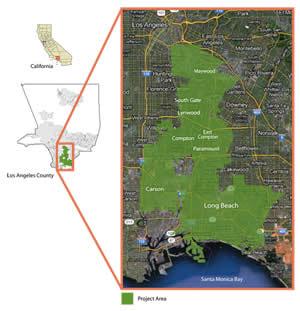
The Los Angeles Environmental Enforcement Collaborative is Region 9's Environmental Justice Showcase Community. The densely populated communities closest to the I-710 freeway in Los Angeles County are severely impacted by pollution from goods movement and industrial activity. One goal of the partnership EPA has formed with state and local agencies is to improve compliance with environmental laws by targeting inspections and enforcement at the state, federal, and local levels to address community concerns.In fiscal year 2010, twenty percent of the Region’s California inspections occurred in the showcase project area. This translates to Regional inspections at more than 70 different facilities, including petroleum and metal plating facilities. The enforcement actions at these facilities will keep over 15,000 pounds of pollution per year out of the local environment and prevent the potential of release of 80,000 gallons of oil into local water sources.
Community leaders developed a comprehensive list of environmental issues and shared it with Regional Administrator Jared Blumenfeld in August 2010. Diesel particulate matter was highlighted as a major concern. In partnership with the California Air Resources Board (ARB), EPA funded the production of anti-idling signs to be placed in communities. Safe schools are a priority to the Los Angeles area community. At the request of local leaders, EPA organized a school siting listening session in Los Angeles to provide an opportunity for community to weigh in on EPA’s National School Siting Policy.
An Environmental Justice State Cooperative agreement was awarded to the Department of Toxic Substances Control (DTSC) to focus community driven-enforcement and capacity building in several communities in the showcase area. Through this partnership DTSC has provided a series of trainings in the community of Maywood, CA that can be replicated in other communities in the focus area. Maywood is one of the most densely populated communities in California and is surrounded by highly-industrial cities. Translation was provided at several meetings in Maywood focusing on topics including drinking water and mobile source pollution using the showcase funding.
In 2011 and 2012, Region 9 will work with the Los Angeles Collaborative for Health and Environmental Justice in support of the Clean Up Green Up campaign, an effort focused on three LA area communities-- Boyle Heights, Wilmington and Pacoima.
For more information or to become involved, please contact Zoe Heller (heller.zoe@epa.gov) at 415-972-3074.
Region 10 EJ Showcase Community: Yakima Valley, WA
Overview
EPA Region 10 is addressing multiple environmental home health stressors in the Latino and tribal communities in the Yakima Valley. A coordinated effort between state, local, and non-profit partners is being used to address the range of exposures found in the community, with a primary focus on reducing exposure through contaminated private well drinking water. This is being accomplished by assessing homes with contaminated wells, providing ‘treatment at the tap’ mitigation, and reducing pollution sources through available regulatory tools and best management practices.
Successes
- Tested 600 private wells for nitrate contamination.
- Sampled crop fields, dairies, and sewage treatment units to link nitrate contamination to sources.
- Partnered with Yakima County through a $400,000 state grant to install well water filters in 166 homes.
- Added significant value to Region 10 and state assistance efforts.
- Supported an air quality issues meeting attended by over 100 stakeholders.
- Developed a comprehensive GIS tool of the Yakima Valley to guide the nitrate investigations; the tool is now being used to track other environmental health concerns in the community.
- Supported a situation assessment of over 23 groups and 65 stakeholders to identify areas of common ground on divisive issues pertaining to the cleanup of groundwater contamination.
History

Region 10 is working in the Yakima Valley of Washington state to address multiple environmental health stressors in drinking water and air in this intensely farmed rural area. Coordination within EPA programs and with tribal, state, and local governments, non-profits, university, and community partners is a key to reducing exposure of the rural poor residents to nitrate contaminated private well water. In the spring and summer of 2010, nearly 20% of the 500 homes assessed by EPA exceeded the federal standard nitrate standard of 10 parts per million (ppm). EPA sampling included research to link nitrate contaminated wells with the source, and the report is anticipated in the spring of 2011.
Yakima County recently received a $400,000 state grant to install point of use reverse osmosis systems on homes with elevated nitrate wells and at-risk family members, including infants, pregnant women, and immune compromised adults. Systems will be installed on up to 400 homes in 2011; however current estimates are that up to four times that many wells may be impacted by nitrate contamination.
Through 2011, EPA will provide families with certified drinking water analysis of their well water to raise awareness of their health risk and allow them to quality for the county-provided treatment systems. Efforts to reduce nitrate pollution may include enforcement actions under the Safe Drinking Water Act and increased use of best management practices from sources of nitrate including commercial fertilizer and animal waste. A situation assessment, conducted in the summer of 2010 by the Yakima-Kittitas Dispute Resolution Center, provided seven recommendations on how the various agencies and organizations can move forward on a common goal to reduce nitrate contamination.
The Yakama Reservation includes over 1 million acres of land within the Yakima Valley, and EPA Region 10 implements the Federal Air Rules for Reservations (FARR) to reduce air quality impacts to residents within the airshed. Community concerns on high asthma rates and other air quality impacts will be considered during a forum to be held on the Yakama Reservation in the spring of 2011. Results of the air quality forum may lead to revisions of the FARR regulations with the goal to improve air quality on the reservation.
For more information or to become involved, please contact: Sandy Halstead (halstead.sandra@epa.gov), 509-786-9225 or Wenona Wilson, 206-553-2148.
